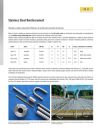Stainless steel reinforcing bar
Molybdenum (Mo) is used in several types of stainless steel to improve corrosion resistance, particularly pitting and crevice corrosion resistance in chloride-containing solutions.
Stainless Steel Reinforcing Bars (rebars)
released in 2007
Mo-containing stainless steels and reinforced concrete bridges
When it comes to building or repairing reinforced concrete bridges so that life-cycle costs are minimized, many authorities are specifying the use of stainless steel reinforcing bars (rebars) instead of the traditional carbon steel rebars.
Stainless steels containing molybdenum (Mo) are the alloys of choice when "stainless rebar" is specified. The most commonly specified alloys are shown below (nominal compositions in weight %, balance iron):
commonly specified grades for stainless steel rebar
| Grade | Type | UNS No | Cr | Ni | Mo | N | C max. |
|---|
| Type 316 |
austenitic |
S31600 |
17 |
12 |
2-3 |
|
0.08 |
|---|
| Type 316L |
austenitic |
S31603 |
17 |
12 |
2-3 |
|
0.03 |
|---|
| Type 316LN |
austenitic |
S31653 |
17 |
12 |
2-3 |
0.13 |
0.03 |
|---|
| Alloy 2205 |
duplex |
S31803 |
22 |
5 |
3 |
0.16-0.17 |
0.03 |
|---|
These alloys can provide long-term corrosion resistance when concrete is exposed to chloride-containing environments, e.g., road salts and sea water. They have been used as rebar in highway bridges, ramps & barrier walls, parking garages, sea walls & marine facilities, building foundations & restorations, and tunnels.
The US Federal Highway Administration (FHWA) organized extensive corrosion testing to find rebar materials that could extend the lifetime of reinforced concrete bridges to 75-100 years, when the concrete was contaminated with chlorides. Their 1998 report concluded that Type 316 stainless steel rebars would be capable of providing that required lifetime.
In Europe, Mo-containing stainless steel rebars have been widely used over the last 20+ years. In North America, their use in highway bridges has been steadily growing over the last 10 years, with many large bridges being constructed or extensively repaired. Two highway bridge projects that are currently underway help to illustrate the use of stainless rebar in the USA.


